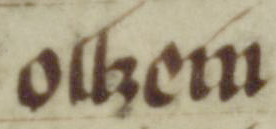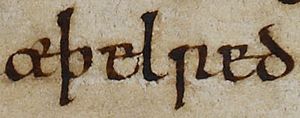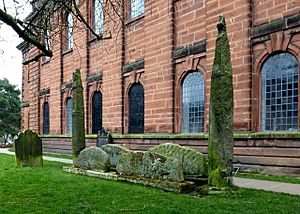Owain ap Dyfnwal (died 1015) facts for kids
Quick facts for kids Owain ap Dyfnwal |
|
|---|---|

Owain's name as it appears on folio 60r of Oxford Jesus College 111 (the Red Book of Hergest): "owein".
|
|
| King of Strathclyde | |
| Predecessor | Máel Coluim |
| Successor | Owain Foel |
| Died | 1015 |
| Father | Dyfnwal ab Owain |
Owain ap Dyfnwal (died 1015) was a ruler of the Kingdom of Strathclyde in the early 11th century. He was likely the son of Dyfnwal ab Owain, King of Strathclyde. Owain probably became king after his cousin, Máel Coluim, King of Strathclyde, passed away.
During his time as king, Owain faced a huge invasion from Æthelræd II, King of the English. Owain died in 1015. After him, Owain Foel became king, who might have been Owain's nephew.
Owain's Family and Becoming King
Owain was probably the son of Dyfnwal ab Owain, King of Strathclyde. Dyfnwal ruled the Kingdom of Strathclyde for much of the 10th century. This was from about the 930s to the 970s.
It's not fully clear when Dyfnwal stopped being king. He seems to have left the throne by the 970s. His son, Rhydderch, might have been king for a short time. However, no old records clearly say this.
English records show that Dyfnwal's other son, Máel Coluim, was king in 973. This was while Dyfnwal was still alive. Owain likely became king after Máel Coluim died in 997.
| Simplified family tree of the Cumbrian kings. Owain is highlighted. These men likely ruled as King of Strathclyde. | |||||||||||||||||||||||||||||||||||||||||||||||||||||||||||||||||||||||||||||||||||||||||||||||||||||||||||||
|---|---|---|---|---|---|---|---|---|---|---|---|---|---|---|---|---|---|---|---|---|---|---|---|---|---|---|---|---|---|---|---|---|---|---|---|---|---|---|---|---|---|---|---|---|---|---|---|---|---|---|---|---|---|---|---|---|---|---|---|---|---|---|---|---|---|---|---|---|---|---|---|---|---|---|---|---|---|---|---|---|---|---|---|---|---|---|---|---|---|---|---|---|---|---|---|---|---|---|---|---|---|---|---|---|---|---|---|---|---|
|
|||||||||||||||||||||||||||||||||||||||||||||||||||||||||||||||||||||||||||||||||||||||||||||||||||||||||||||
Attacks on Owain's Kingdom
Old records don't say much about the Cumbrian kingdom between 975 and 997. So, we don't know much about Owain's time as king. Around the year 1000, Owain was likely in his fifties or sixties. He seems to have faced an attack from the English.
The Anglo-Saxon Chronicle, an old English history book, says that Æthelræd II, King of the English launched a big attack on the Cumbrian kingdom in the year 1000. The English army is said to have destroyed almost all of the country.
However, the English navy, based at Chester, could not meet up with the land army. This was probably due to bad weather. Instead, the navy attacked the Isle of Man. This attack on the Isle of Man could mean the English navy first planned to go into the Firth of Clyde. Or, they might have planned to attack both the Cumbrians and the people of the Isles.

We don't know exactly why King Æthelræd attacked the Cumbrians. It might have been to show his power to his northern subjects and neighbors. Another idea is that Æthelræd's invasion was because the Cumbrians were helping Viking forces in the area. The attack might have been aimed at Viking bases in the Irish Sea region.
The same old record also says that an "enemy fleet" sailed to Normandy that year. But it doesn't say why. Another old book, the Chronicon ex chronicis, says this fleet left before Æthelræd's attack. This might explain why Æthelræd was free to attack another country. It's even possible that the English had made a deal with a Viking army in England. Then, they sent one part of this army to fight the Cumbrians and another to attack the Normans.
Around Owain's time, Brian Bóruma mac Cennétig, High King of Ireland was a powerful leader. In 1006, he gathered a huge army in southern Ireland. He marched through the north of Ireland to show his strength. An old Irish book, Cogad Gáedel re Gallaib, says that Brian's navy collected taxes from Saxons and Britons. They also collected taxes from Argyll, the Lennox, and Alba (Scotland).
This could mean that Brian's Viking forces, perhaps led by Sitriuc mac Amlaíb, King of Dublin, fought against areas controlled by the Cumbrians. They might also have fought the English people of Lothian or the western coast of Northumbria. Just the year before, Máel Coluim mac Cináeda became King of Alba (Scotland). An old Scottish prophecy book calls this king an "enemy of Britons." It also seems to talk about battles against the islands of Islay and Arran. This might be about Brian's overseas actions or a rivalry between Brian and the Scottish king.
Also in 1006, an old record says that the Scots went into Northumbria. They surrounded Durham but were driven back by Uhtred. He was the son of a powerful northern English leader. The fact that the Cumbrians are not mentioned in this Scottish attack could mean that the English invasion in 1000 had weakened the Cumbrian army. Or, it might mean the Cumbrians had agreed to certain terms with King Æthelræd after his attack.
Owain's Death and Who Ruled Next

According to an old Welsh history book, Annales Cambriæ, Owain was killed in 1015. Other old texts, Brut y Tywysogyon and Brenhinedd y Saesson, also confirm his death. These records suggest he died in battle, but we don't know the details.
It's possible these records refer to Owain Foel, King of Strathclyde, who had a similar name. However, there is evidence that Owain Foel lived for years after 1015. So, the records about Owain's death are likely correct. If these two Owains were different people, they were probably related. Owain Foel might have been the son of Owain's brother, Máel Coluim.
Having two Cumbrian rulers named Owain at the same time could explain why Owain Foel was called "the bald" (Foel means "bald"). An old history book, Historia regum Anglorum, says that Owain Foel helped the Scottish king, Máel Coluim mac Cináeda, fight the English at the Battle of Carham in 1018.
Owain himself, or his grandfather Owain ap Dyfnwal, or even his later successor Owain Foel, might be the legendary figure Owain Caesarius. This figure is linked to ancient monuments at Penrith, known as The Giant's Grave. A nearby place called Castle Hewin means "Owain's castle." This place might also be named after the same person.
Another person named Owain ap Dyfnwal was reportedly killed in 990. This is mentioned in old Welsh history books like Annales Cambriæ.


